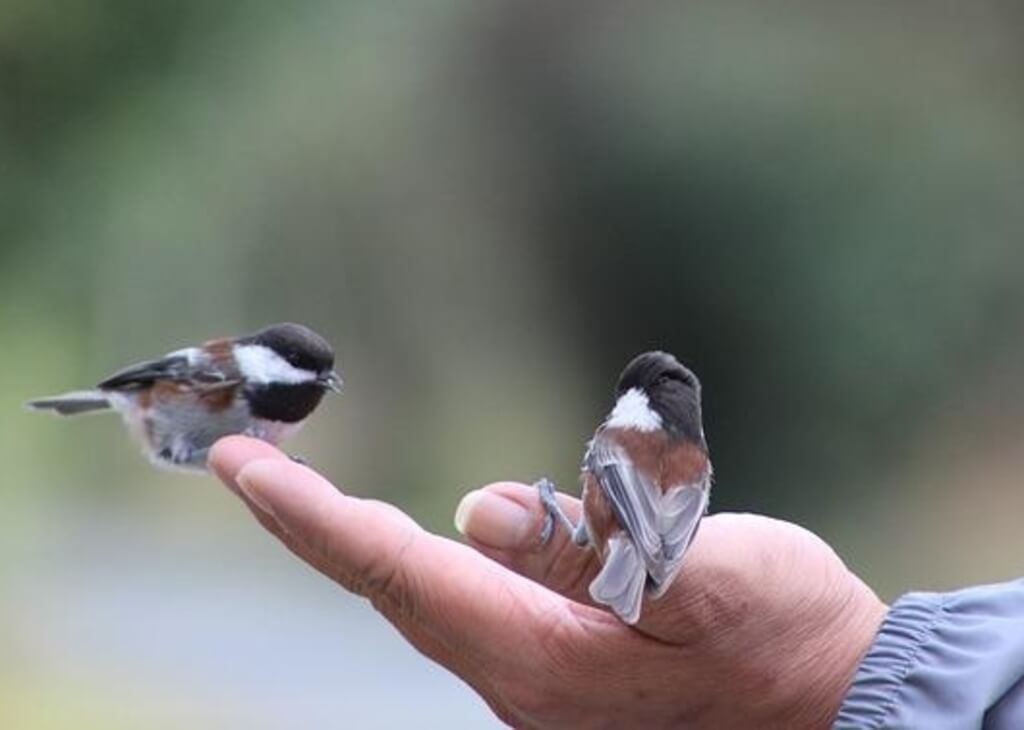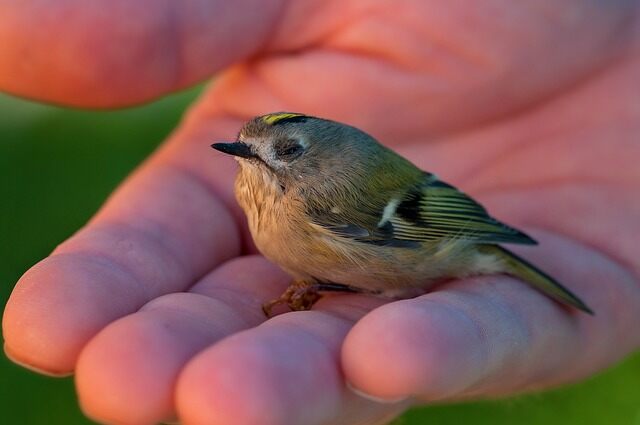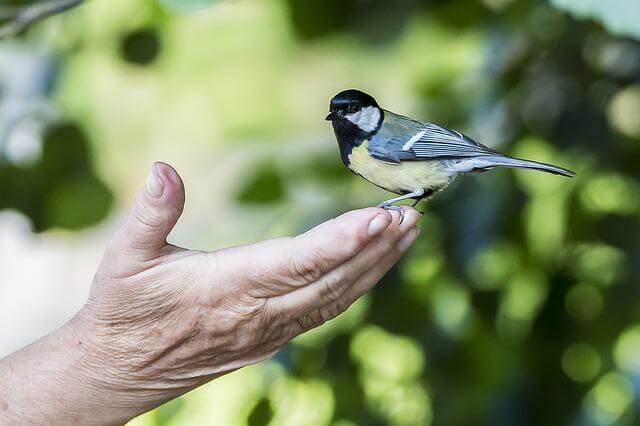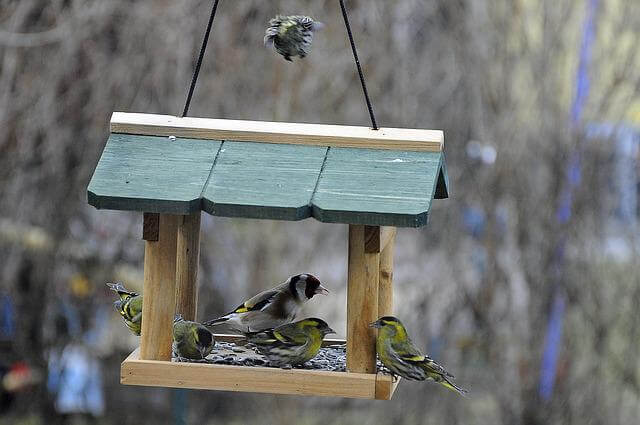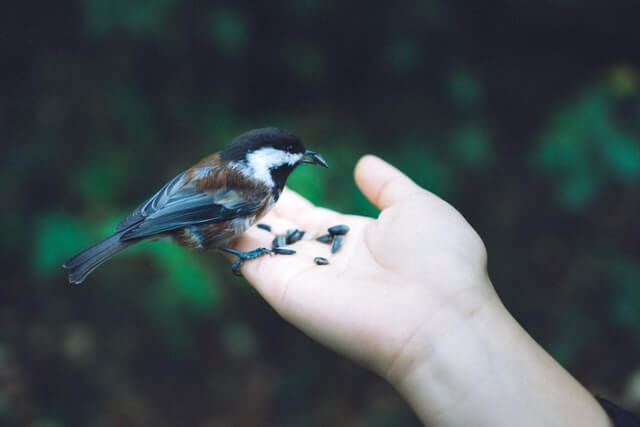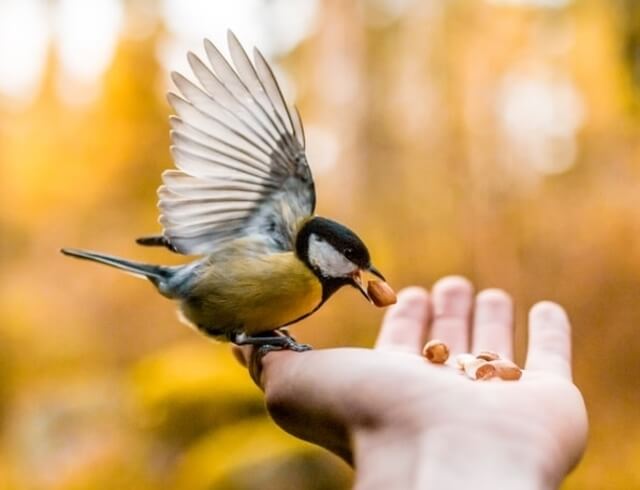Embark on a journey to befriend wild birds as we delve into the art of gaining their trust. Wondering how to get a wild bird to trust you? This article unveils foolproof tips and techniques, ensuring you become their newfound confidant and best feathered friend.
Table of Contents
- 1 Key Takeaways:
- 2 How do you get a wild bird to trust you?
- 3 How long does it take for a bird to trust you?
- 4 Does my bird trust me?
- 5 How do you get your bird to trust you?
- 6 How to get a wild bird to perch on your finger?
- 7 How to get a wild bird to come to you without food?
- 8 How to get birds to eat from your hand?
- 9 How to tame a wild bird?
- 10 How to get birds to come to your bird feeder?
- 11 What to feed a wild bird?
- 12 Friendly wild birds
- 13 Is it ok to hand feed wild birds?
- 14 How do you get a lovebird to trust you?
- 15 Can you befriend a wild bird?
- 16 Do wild birds recognize humans?
- 17 How do you calm a scared wild bird?
- 18 What is the friendliest wild bird?
- 19 How do you make wild birds happy?
- 20 How do you know if a wild bird trusts you?
- 21 Do birds watch humans?
- 22 How do you approach a bird without scaring it?
- 23 Why is my bird afraid of me?
- 24 How do you hold a wild bird?
- 25 Author
Key Takeaways:
- Unlock Trust: Master the art of gaining a wild bird’s trust.
- Practical Techniques: Explore effective tips for building a connection.
- Feathered Friendship: Transform into their confidant with proven methods.
How do you get a wild bird to trust you?
Befriending a wild bird is like making a new feathered friend in nature, and it takes a bit of finesse. Here’s how you can go about it:
Observe and Understand:
Spend some time observing the bird from a distance. Learn about its daily habits and what it likes to munch on. This bird-watching groundwork helps you get to know your avian buddy and builds a sort of unspoken understanding.
Take It Slow and Easy:
Patience is the key. Birds have a knack for sensing nervousness, so take your time approaching. Begin by standing a few steps away and gradually inch closer as the bird warms up to your presence. Abrupt movements and loud noises are a no-go—they might spook your feathery friend and make it less likely to cozy up to you.
Win Them Over with Treats:
Food is a universal language, even in the bird world. Use it to your advantage by offering small, enticing treats. Start at a distance and move in as the bird gets more comfortable. It’s like inviting them to a delicious feast that happens to be close to you.
Speak Gently:
Imagine having a pleasant conversation with your new bird pal. Talk to them in soft, calming tones while you’re nearby. This helps create a soothing atmosphere and shows them you’re a friend, not a foe.
In a nutshell, becoming friends with a wild bird is all about being a patient, observant, and friendly presence. Take it step by step, and soon you’ll have a little winged companion who trusts you like a confidant in the great outdoors.
How long does it take for a bird to trust you?
It can take anywhere from a few days to a few weeks for a bird to trust you. Some birds may never fully trust you, but will tolerate your presence. It is important to be patient and not push the bird too hard.
Speak softly and move slowly around the bird. Offer treats or toys to get the bird’s attention. If the bird is comfortable with you, it will start to interact with you on its own terms.
Does my bird trust me?
When it comes to our feathered friends, many of us often wonder if they trust us. After all, we are the ones responsible for their care. So, do birds trust us?
The answer is yes and no. Birds that have been hand-fed or raised by humans often do trust people. They may come when called, and they may let people handle them without fear.
These birds may even try to get close to people, seeking attention. However, birds that have not been handled as much or that were not hand-fed may be more fearful of people.
They may stay away from people and be hesitant to let anyone get too close. Whether or not a bird trusts you ultimately depends on how you interact with it. If you are gentle and patient, the bird will likely learn to trust you over time.
How do you get your bird to trust you?
Birds are one of the most popular pets in the world, and for good reason. They’re beautiful, intelligent, and can be a lot of fun to have around. However, if you want to build a strong relationship with your bird, you need to start by gaining its trust. Try these tips::
1. Be patient. It may take some time for your bird to warm up to you. Don’t get discouraged if it doesn’t show immediate trust. Just keep interacting with it regularly and be consistent in your behavior.
2. Build a positive relationship with your bird. Show it that you’re trustworthy and reliable by being consistent in your interactions with it. Give it plenty of attention and praise when it does something good.
3. Respect its space.
How to get a wild bird to perch on your finger?
Wild birds can be a great addition to any backyard bird watching enthusiast’s life, but getting them to perch on your finger can be a challenge. Here are a few tricks and tips on how to get a wild bird to perch on your finger.
First, you need to find a bird that is comfortable around people. This is usually easier with smaller birds, such as songbirds.
One way to get a bird to perch on your finger is to offer it a treat. Try holding a small piece of food in front of the bird and then slowly bringing your hand closer to it until the bird hops up onto your finger.
Another way to get a bird to perch on your finger is by imitating its natural behavior. Try crouching down next to the bird and slowly extending your arm out towards it. The bird will likely hop up onto your hand if it feels comfortable doing so.
How to get a wild bird to come to you without food?
There are a few ways to get a wild bird to come to you without food. One way is to make sure the bird sees you as a friendly presence.
Talk in a soft voice and try not to scare the bird. If the bird is close by, slowly reach out your hand, so it can see you are not a threat.
Another way is to provide water nearby. Birds will often come to drink or bathe if there is water available. Finally, make sure there are plenty of places for the bird to perch nearby.
Birds feel safer when they have a place to rest and watch their surroundings. By providing all of these things, you can encourage a wild bird to come closer and maybe even land on your hand!
How to get birds to eat from your hand?
Birds are known to be attracted to feeders that offer a variety of seeds. However, many people would love to be able to hand-feed birds as well. By following a few simple tips, you can learn how to get birds to eat from your hand!
One important thing to note is that you should never try to force a bird to eat from your hand. Instead, let the bird approach you on its own terms. Start by sitting or standing still and allowing the bird to get used to your presence.
Once the bird feels comfortable around you, slowly extend your hand outwards. If the bird is interested in getting food from your hand, it will eventually fly over and land on your palm. Reward the bird with a small amount of food once it begins eating from your hand.
Extra Tips
- It is not as difficult as it may seem, but there are a few things that you need to keep in mind. First and foremost, it is important to have patience. Birds are not going to just jump up onto your hand and start eating out of your palm. You need to slowly work them up to it.
- Another thing that you need to remember is that different kinds of birds will respond differently to being fed from your hand. For example, smaller birds like chickadees or finches may be more comfortable being fed this way.
How to tame a wild bird?
One of the most rewarding experiences a bird enthusiast can have is taming and training a wild bird. It can be a challenge, but it’s definitely doable with persistence and patience. The first step is to get close to the bird. You can do this by putting out food and water or offering a perch near where the bird hangs out.
Once you’ve gained the bird’s trust, you can start working on getting it to come to you. It may take a while, so be sure to be patient. Offering treats is one way to entice the bird closer. You can also try whistling gently to get its attention.
Once the bird is coming close, start working on getting it to step onto your hand. Again, this may take some time, but with patience and persistence you’ll be able to tame even the wildest of birds!
How to get birds to come to your bird feeder?
One of the joys of having a backyard is enjoying the sight of birds visiting your feeder. However, getting birds to come to your feeder can be tricky. To help you get started, here are some tips.
1) Place your feeder in an open area where there is plenty of space for birds to fly around. Avoid placing it near dense shrubs or trees, as these can make it difficult for birds to see the feeder.
2) Make sure your feeder is stocked with fresh food. Birds will be less likely to visit a feeder that is full of old, stale food.
3) Keep the area around your feeder clean and free of debris. Dirty feeding areas can discourage birds from visiting.
4) Offer a variety of food types at your feeder, including seeds, nuts and fruits.
5) Place a birdbath beside the bird feeder.
Related Post: How To Attract Birds To A New Bird Feeder: Expert Tips!
What to feed a wild bird?
When it comes to what to feed a wild bird, there are many options. Seeds, nuts, fruits, and insects are all great choices. It’s important to provide a variety of food items to ensure the bird gets the nutrients it needs.
Seeds are a great source of protein and fat, which birds need for energy. Sunflower seeds are a popular choice, but other seeds such as millet and cracked corn can also be fed.
Nuts provide essential fatty acids and vitamins that birds need. They also help birds build strong bones and feathers. Nuts that are good for birds include almonds, pecans, and hazelnuts.
Fruits provide water and essential vitamins and minerals for birds. Some good choices include grapes, apples, oranges, and berries.
Insects are an excellent source of protein for birds.
Friendly wild birds
Birds can be a gardener’s best friend. Not only do they eat pesky insects, but many species also help pollinate flowers. And if you provide them with food and water, they’ll stick around to help keep your garden healthy.
The key to attracting birds is to provide them with what they need: food, water, and shelter. In the spring and summer, offer birdseed in a feeder or scattered on the ground.
Suet pellets are also a favorite of many birds. Make sure to keep your birdbath clean and filled with fresh water, and place a few logs or rocks in your garden for birds to perch on.
Some of the friendliest birds for gardens include chickadees, bluebirds, wrens, and hummingbirds. Be sure to watch for these visitors and enjoy their company!
Is it ok to hand feed wild birds?
There is no right answer when it comes to hand feeding wild birds. Some bird enthusiasts believe it is ok to do as long as you take the necessary precautions, such as washing your hands thoroughly after each feeding.
Others believe that hand feeding can pose a health risk to both the birds and people, as birds can spread diseases like salmonella.
There are pros and cons to consider when deciding whether or not to hand feed wild birds. Ultimately, it is up to the individual to decide what they feel comfortable with.
How do you get a lovebird to trust you?
Lovebirds can be skittish and wary of new people, so it can take some time to get them to trust you. One way to speed up the process is to offer them treats.
This will help them associate you with positive things and make them more likely to trust you. Be patient and keep interacting with your lovebird regularly; eventually, they’ll come to see you as a friend.
Can you befriend a wild bird?
Yes, it is possible to befriend a wild bird. In fact, many people have formed close bonds with birds that they’ve found in their backyards or while on nature walks.
It’s important to remember that these birds are still wild and should be treated with caution, but if you’re kind and gentle, you may be able to earn their trust.
Some things you can do to win over a wild bird include providing food and water, building a bird feeder or bird bath, and offering shelter.
You can also learn about the bird’s habits and behavior so that you can better understand how to interact with it. It may take some time for the bird to get used to you, but eventually it will likely come to see you as a friend.
Do wild birds recognize humans?
Some research suggests that some birds can indeed recognize humans. Magpies, crows, and mockingbirds have all been shown to be able to distinguish between different human individuals.
These birds are able to remember people who have harmed them in the past, and sometimes even attack humans who they don’t recognize.
However, not all bird species are capable of this level of recognition. For example, sparrows likely don’t pay much attention to humans unless they’re actively trying to get close to them. Similarly, most other small songbirds probably aren’t very aware of us at all.
How do you calm a scared wild bird?
Calming a scared wild bird can be difficult, but there are a few things you can do to help the bird feel safe and calm down. One thing you can do is to speak softly to the bird and try to keep your movements slow and gentle.
You can also try offering the bird some food or water to help distract it from its fears. If possible, try to place the bird in a quiet, dark place where it can feel safe until it calms down. If the bird is still too scared, it’s best to leave it alone and let it calm down on its own.
What is the friendliest wild bird?
There are many different types of wild birds, and each has its own personality. Some birds are more social than others, and some are more aggressive. So, what is the friendliest wild bird?
The answer to that question depends on your definition of friendly. If you’re looking for a bird that will come up to you and land on your hand, then the chickadee is probably the friendliest. These small birds are common in North America and Europe, and they love to interact with people.
Another friendly bird is the bluebird. These pretty creatures can be found all over North America, and they love to perch on people’s heads or shoulders. Bluebirds are known for being very docile, and they rarely fly away when people approach them.
How do you make wild birds happy?
Wild birds are some of the most beautiful creatures on Earth. They can also be very happy. You can make wild birds happy by providing them with food, water, and shelter.
You can also make them happy by providing them with a place to raise their young. Wild birds will be happiest when they have a place to call home.
How do you know if a wild bird trusts you?
If you want to know how to tell if a wild bird trusts you, there are a few things you can look for. One is if the bird is comfortable being around you and coming close. If it stays at a distance or seems scared, it probably doesn’t trust you yet.
Another thing to look for is how the bird reacts when you move. If it stays calm and doesn’t fly away, that’s another good sign. If you can, try offering the bird some food or water. If it takes the food from your hand, that’s another sign of trust.
Do birds watch humans?
Birds have been known to observe people for a variety of reasons. For example, they may watch us to see if we’re going to provide them with food, or to determine whether we’re a threat.
Some species of birds have even been known to mimic human vocalizations! Whatever the reason may be, it’s clear that birds are interested in what we do and they watch us closely.
How do you approach a bird without scaring it?
There is no one-size-fits-all answer to this question, as the best way to approach a bird will vary depending on the individual bird’s personality and behavior.
However, some tips on how to approach a bird without scaring it include being calm and quiet, not making sudden movements, and approaching from the side or behind.
It is also important to be patient, and not try to force interaction with the bird. If the bird seems scared or hesitant, back off and give it some space.
Ultimately, the best way to learn how to approach a bird safely is through trial and error, by observing the birds in your area and experimenting with different techniques until you find what works best for you.
Why is my bird afraid of me?
There could be many reasons why your bird is afraid of you. One reason may be that you have been too rough with your bird in the past. Birds are delicate creatures and should be treated with care. If you have been grabbing your bird or handling it roughly, it could explain why your bird is now afraid of you.
Another possibility is that you have been too noisy around your bird. Birds are very sensitive to noise and if you have been making a lot of loud noises near your bird, it could be the reason why he or she is now scared of you.
Finally, another potential reason for your bird’s fear could be that you have never interacted with him or her before. If this is the case, your bird may not feel comfortable around you and will be scared until he or she gets to know you better.
How do you hold a wild bird?
When you catch a wild bird, the first thing you need to do is determine if it is injured. If the bird is injured, you need to seek help from a professional. If the bird appears to be healthy, you can proceed to hold it.
The best way to hold a wild bird is by using your hand as a perch. Place your thumb and first 2 fingers behind the bird’s wings and your little finger in front of the legs. Gently cup the bird’s body with your hand and support its weight.
Do not squeeze the bird or hold it too tightly. You want to make sure that the bird feels secure and that it cannot escape. Hold the bird upright and avoid tipping it over.
If you are going to release the bird back into the wild, be sure to do so as soon as possible.
For larger birds, it is usually best to place one hand under their body and support their weight, while using your other hand to grasp their head or neck. Be careful not to hold a bird too tightly, as this can cause injury or stress.

